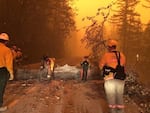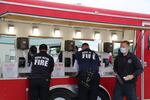Wildland firefighters had a lot to contend with this year as fires raged across the West during a global pandemic.
More than 9,000 people were called in to fight large wildfires in Oregon and Washington this year, and hundreds of them lived together in fire camps that are known for spreading common viruses often referred to as “camp crud.”
Mariah Rawlins, emergency response manager with the Oregon Office of State Fire Marshal, said everyone was expecting an outbreak of COVID-19 this year.
“The way that fire camps are run it felt sort of inevitable as we went into the season,” she said.
So firefighting agencies took a lot of precautions and spent months redesigning how this year’s fire camps would work.
While wildfires were burning through towns, leveling homes and sending thousands of people to evacuation centers across Oregon, firefighters were working to contain the flames while also adhering to a rigorous new set of rules designed to prevent the spread of coronavirus.
There were daily health screenings, boxed meals, social distancing rules and mask requirements. Firefighters in the two-state region were organized into units, with a smaller number of people they would be interacting with to minimize exposure potential.
The result? Rawlins says there were just seven confirmed cases of COVID-19 among the crews — and no outbreaks, which the state defined as two or more cases in any one camp.
“So we all feel very relieved," she said. “And we all feel like the efforts that were taken by the fire service really did play out in everyone’s favor. We did have a whole plan of how we would communicate and handle an outbreak, and amazingly enough we didn’t have to do that.”

Wildland firefighting crews fighting the Holiday Farm Fire work to clear a felled tree obstructing a road in the Willamette National Forest on Wednesday, Sept. 8, 2020.
Courtesy of Willamette National Forest / U.S. Forest Service
The “COVID module” implemented by fire agencies statewide included a dedicated health liaison and COVID-19 responders who were assigned to each fire camp specifically to deal with potential cases, Rawlins said.
One surprisingly effective strategy was to give firefighters who had gone through their daily health screenings a colored wrist band.
“We learned it made people feel so much more comfortable to see that everyone in the room has a purple wrist band," she said. “It was that peace of mind that everyone was following the process.”
When wildfires broke out across the state in early September and firefighting resources were stretched thin, “that’s where having the COVID staff and health liaisons really helped us,” Rawlins said. “Regardless of what things looked like in the rest of the state, they had that one mission.”
Training for a pandemic wildfire training
The training for this year’s wildfire season started way back in June with a shift to outdoor classrooms and smaller class sizes, lots of sanitizing and handwashing. The Oregon Department of Forestry normally uses live fire to train new recruits, but in Southern Oregon it decided not to in order to minimize the smoke that could increase the health risks of COVID-19 for people living nearby.
“We just don’t know about how smoke can enhance the transmission of COVID,” Larson said. “I did not want to create more smoke in the air. Even if it was for training purposes. It just really wasn’t worth taking that risk of exposing the public to smoke."
So new recruits like Ayva Burkhart did their “pump and roll” training by trying to put out a fake fire on a concrete helipad.
“They’ve still been able to illustrate things in such a way that it’s like, OK, this is where the fire’s going to be ... and you can really just imagine it in your head,” she said.

Firefighters use a hand-washing station with socially distanced sinks at a training event in June 2020.
Cassandra Profita / OPB
She and other trainees had to take their own temperature at the beginning of each day and check for symptoms of COVID-19, but Burkhart said she never considered staying home to avoid the risk of the pandemic.
“Because you’re working towards something," she said. "You’re saving people’s homes or their land. I’m in love with this. This is what I want to do.”
Bill Smith, wildland fire supervisor for ODF, said one of the biggest fears this fire season was losing firefighters to COVID-19.
“We hire a certain amount of people every summer," he said. "If we turn out to have a dent in our ranks from coronavirus there’s nobody we have in the wings waiting to replace those folks. That’s why it’s super important that we stay vigilant on this because we cannot afford to do it with less people than we have now.”
While the crews needed all the firefighting help they could get this season, they didn’t see big losses in personnel from COVID-19.
For many firefighters, the pandemic was just one more hazard they had to look out for in a very dangerous season.
“There’s so many risks, and it’s scary,” said ODF firefighter Angel Pinto. "At a moment’s notice, a tree can fall, there can be a rock falling from a cliff. But it’s very rewarding at the end. You know, I take these risks for a reason. I want to help. I want to give back.”
Dave Larson, district forester for ODF in Southern Oregon, said while there were numerous firefighters who were tested for COVID-19 because they had some symptoms, only seven tests came back positive, and each of them were from different fire camps.
“There was a lot of fire on the landscape. It was a challenging time,” he said. “But there was no large outbreak like I was expecting in a fire camp. I’d like to say it’s all our guidelines and procedures, but I also think we just got blessed or lucky.”
